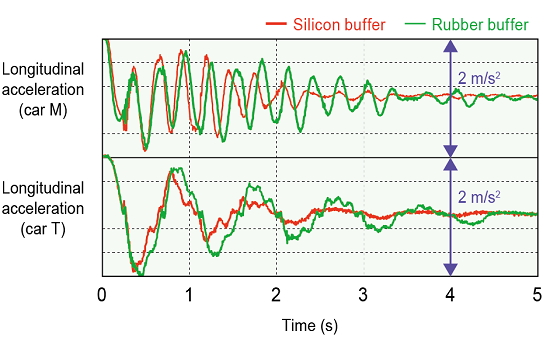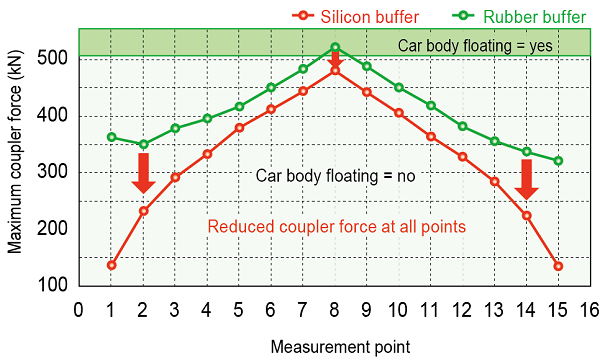8. Silicon buffers on passenger cars provide longitudinal ride comfort and improved safety in train breakdown operations
Most rubber buffers currently in use on passenger cars are designed with no initial pressure, in order to maximize ride comfort. However, some initial pressure is needed during train breakdown operations so that the buffers can absorb more energy, which reduces the risk of trainset buckling.
Buffers are thus required to perform two conflicting functions: maximizing ride comfort while minimizing the trainset buckling risk.
We developed a silicon buffer unit for passenger cars (see Figure 1) that features an internal attenuating element designed to generate a measured level of attenuating force in response to longitudinal movement between cars.
We installed the new silicon buffer on a two-car train at the Railway Technical Research Institute and performed a running test with the brakes disconnected on one of the cars (car T).
The test shows immediate attenuation in longitudinal vibration (see Figure 2). The silicon buffer was also found to improve the ride quality level, reducing longitudinal vibration by up to 6.5 dB compared to conventional rubber buffers. In a numerical simulation of a breakdown operation involving two 8-car trains, the longitudinal force (coupler force) acting on couplers was found to be lower at all points when rapid deceleration equivalent to emergency braking was applied at a speed of 10 km/h. There was no indication of car body floating (with associated risk of derailment) at any point.
This indicates that train breakdown operations can be performed safely without needing to expel air from the air springs (see Figure 3). Thus we showed that replacing existing rubber buffers with the new silicon buffers will improve ride comfort in the longitudinal direction while also mitigating the risk of trainset buckling during breakdown operations.
Other Contents
- 1. Rapid seismic damage estimation tool for large bridges
- 2. Seismic diagnostic for existing pile foundations affected by nearby excavation work
- 3. Earthquake countermeasure for poles on viaduct using stays and overhead wires
- 4. Rainfall-damaged embankment safety assessment tool
- 5. Creation of time-varying dynamic wind maps
- 6. Braking performance improvement under snow conditions by controlling wheel temperature using snowproof brake systems
- 7. Platform safety support device using side-mounted cameras
- 8. Silicon buffers on passenger cars provide longitudinal ride comfort and improved safety in train breakdown operations
- 1. Rapid seismic damage estimation tool for large bridges
- 2. Seismic diagnostic for existing pile foundations affected by nearby excavation work
- 3. Earthquake countermeasure for poles on viaduct using stays and overhead wires
- 4. Rainfall-damaged embankment safety assessment tool
- 5. Creation of time-varying dynamic wind maps
- 6. Braking performance improvement under snow conditions by controlling wheel temperature using snowproof brake systems
- 7. Platform safety support device using side-mounted cameras
- 8. Silicon buffers on passenger cars provide longitudinal ride comfort and improved safety in train breakdown operations



